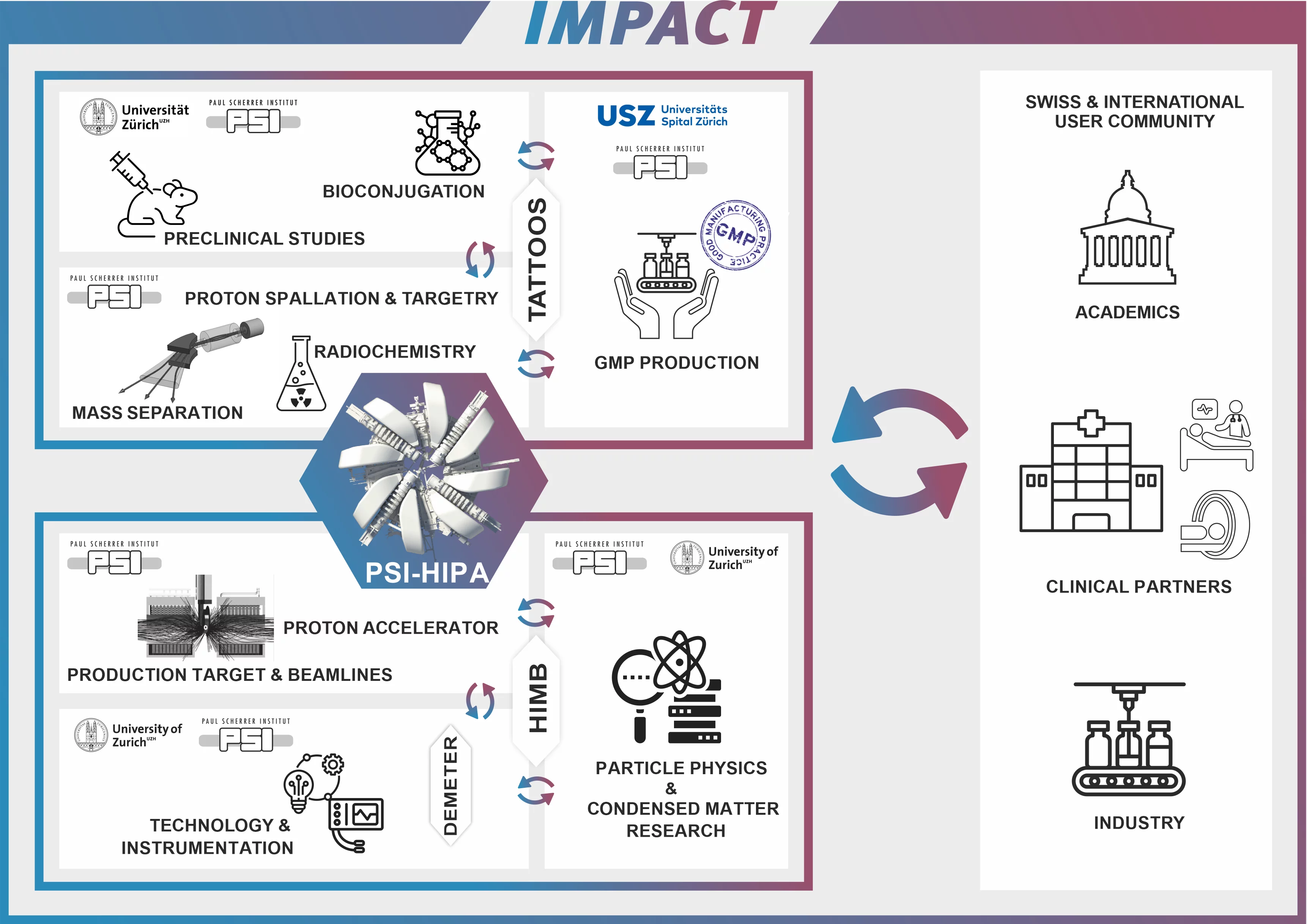The High Intensity Proton Accelerator complex HIPA at the Paul Scherrer Institute (PSI) plays a pivotal role in Swiss large-scale infrastructure. HIPA’s Ring Cyclotron is the most powerful proton cyclotron worldwide and among the most energy efficient accelerators. It provides a world-leading 1.4 MW high-intensity proton beam of 590 MeV energy and up to 2.4 mA of beam current to target stations, simultaneously feeding 30 instruments and experiments with intense beams of low-energy secondary particles of neutrons, pions and muons for research in multiple disciplines. HIPA presently fuels three large-scale user facilities, namely, the Swiss spallation neutron source SINQ, the Swiss Muon Source SμS, and the Swiss Research InfraStructure for Particle physics CHRISP. Radionuclides are currently developed and produced at SINQ and at the IP2 beamline, fed protons from HIPA’s 72 MeV Injector II cyclotron. When looking back at the last decade (2010-2019), more than 500 user proposals per year were submitted, about 900 individuals per year made 1700 user visits to the site and spent more than 11000 user days per year at the facilities, using more than 2800 instrument days. More than 300 publications per year resulted from this work.
The IMPACT (Isotope and Muon Production using Advanced Cyclotron and Target technologies) project, jointly proposed by PSI and the University of Zürich (UZH), aims to produce and fully exploit unprecedented intensities and quantities of muons and radionuclides at HIPA for advancements in particle physics, chemistry, material sciences and life sciences. Two new target stations, one for high-intensity muon beamlines (HIMB), and one for an online isotope separation facility (TATTOOS: Targeted Alpha Tumour Therapy and Other Oncological Solutions), will boost the existing infrastructure: HIMB will provide two orders of magnitude higher muon intensities and TATTOOS unrivalled quantities of a wide range of radionuclides.
IMPACT, combining HIMB and TATTOOS, has emerged from a bottom-up process of the Swiss research community. HIMB and TATTOOS have been put forward in the discipline-specific roadmaps of CHIPP and of Chemistry, respectively, in the SCNAT-coordinated process to inform the 2023 Swiss Roadmap for Research Infrastructures. Existing and new state-of-the-art facilities at PSI, UZH (in particular, its DEMETER center) and the Zürich University Hospital (USZ) integrated with IMPACT, will maximize the reach of this national research infrastructure. The project partners have demonstrated records in building and operating large-scale infrastructures; in developing novel technologies for detectors, instrumentation and medical applications; and in running successful user research programs. The image above gives an overview of the full IMPACT project.
The unprecedented muon intensities will serve new experiments and instrumentation for a broad national and international user community in particle physics and condensed matter research, at CHRISP and SμS, as documented in the recently published HIMB science case document. A vastly enlarged discovery potential will challenge the Standard Model of particle physics, in particular in the crucial area of charged lepton flavour violation. Together with new detector technology, completely new material science studies will become possible, e.g. concerning novel quantum materials, with much smaller sample sizes, in much shorter times, at a much broader range of conditions, in particular at very high pressures. PSI and UZH, together, will develop new instrumentation and establish new technologies for particle detection and sample environments leading to quantum leaps in muon sciences, overcoming statistical limitations and accessing a wide, uncharted parameter space. The technology developments bridge to other applications and fields, e.g. sample environments at other large-scale national and international user facilities, and detector technology for high-energy particle physics, photon science and medical applications. The new instrumentation for TATTOOS, in conjunction with preclinical and clinical capabilities at PSI, UZH, and USZ, will provide difficult-to-obtain heavy, therapeutically interesting radionuclides to serve frontline research in radio-chemistry, radiopharmacy and nuclear medicine. High radionuclide production rates will, for the first time, allow for large clinical studies of novel radiopharmaceuticals for diagnosis and treatment of patients using a theragnostic approach (what one images, is what one treats). Collaboration of the IMPACT project partners and cooperation with a broad national and international community, from the production of the radionuclides to the medical application, are the key to success in this ‘bench-to-bedside’ endeavour. Other than the main focus on medical applications, specific radionuclides for other use cases, such as materials research or fundamental physics, offer exciting prospects for further research directions in Switzerland.
